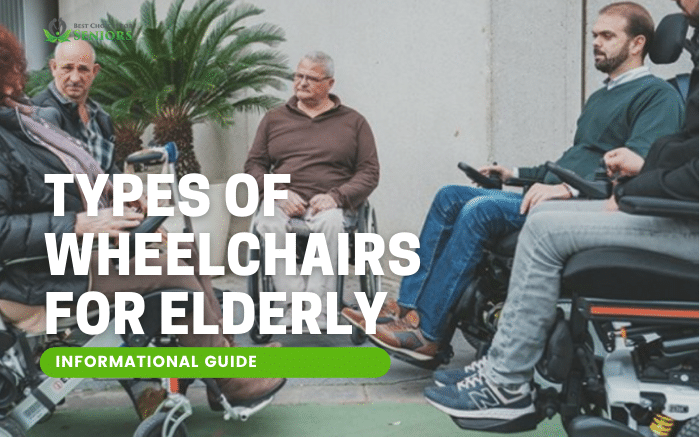There are so many types of wheelchairs for the elderly that we’ve seen many get baffled.
Sources online don’t make it any easier. They provide a long list of categories that changes depending on which site you’re browsing. Some even go on and add a few semi-imaginary names, purely their own invention, to the mix.
Let’s speed past all the confusion and look at a clean, well-defined list of the types of wheelchairs for elderly.
Before we start, there are a couple of major wheelchair pairs that we need to discuss before the other types.
These are the most commonplace of wheelchairs for seniors and older adults. The first set is manual and electric, and the second set is self-propelled and transport wheelchairs.
Manual wheelchairs vs. electric wheelchairs
Manual wheelchairs have been the norm for a long time now. Electric wheelchairs are also called powered wheelchairs, power wheelchairs, or motorized wheelchairs. These differ from manual ones in the fact that they don’t need someone to push or drive them manually. A battery works as the power source that drives the wheelchair. Although this type of wheelchairs is great for people who have disabilities that disallow them from driving a wheelchair manually (such as lack of limbs), powered wheelchairs are suitable for virtually anyone who uses a wheelchair already.
These powered wheelchairs come in different controls such as touchpads or joysticks to make sure people with all abilities can use them. Electric wheelchairs are built for mixed terrain and perform better than manual wheelchairs in covering uneven, rough, or rugged outdoor terrain because of shorter, thicker wheels and motor power.
Going up inclinations is also a breeze with electric wheelchairs.
Self-propelled vs. transport wheelchairs
This is the second major distinction of wheelchairs – one you need to take into consideration very early on while buying one. Self-propelled wheelchairs are those with large rear wheels – meant to be driven by the wheelchair user. Transport wheelchairs are also called transit wheelchairs. These have 4 small wheels and are meant to be driven by a caregiver or driver.
Self-propelled wheelchairs are the traditional mobility aid. Transport wheelchairs are the fresher variation. Transport wheelchairs have additional features that make it easier for someone to drive a patient or an elderly.
Your upper body needs to be in constant work in a self-propelled wheelchair. This is not for everyone.
Tilt and reclining wheelchairs
Although different, they fall in the same broad category of adaptive seating. Tilt wheelchairs are also known as tilting wheelchairs and tilt-in-space wheelchairs. Reclining wheelchairs are also called recliner wheelchairs.
Tilting wheelchairs have a frame that tilts back. These usually tilt 50 degrees back. Tilting wheelchairs are good for people who need to be shifting their posture to eat meals, watch television, talk to doctors, and so on. A caregiver can better reposition a patient with the help of a tilting wheelchair. The risk of injuries becomes very low.
Reclining wheelchairs have a backrest that reclines back. From a nearly vertical 90 degrees position, the backrest can rotate backward up until a nearly horizontal 180 degrees position. This allows the user to slowly transition into a lying position. It allows the user to perform a variety of day-to-day tasks at various angles. Reclining wheelchairs are good for lying down, taking a nap, sleeping, or resting.
Ultralight and light wheelchairs
This group of wheelchairs is different from traditional wheelchairs. Using newer materials and taking out the unnecessary, manufacturers are able to build a durable and compact wheelchair that’s 25 lbs or less. Some even weigh as little as 15 lbs, which can be termed ultralight.
Light wheelchairs (20-25 lbs) are the middle ground between durability and a compact size. Ultralight wheelchairs (below 20 lbs) admittedly have some structural limitations, but if they’re coming from a reliable brand, there are no risks involved.
Bariatric wheelchairs
Bariatric wheelchairs are meant for people with obesity. These wheelchairs are both heavier and wider than conventional wheelchairs. Usually, the upper limit of a traditional wheelchair’s weight capacity is 250-300 lbs. In the case of bariatric wheelchairs, the weight capacity ranges from 450 to 700 lbs and beyond.
The seat widths also usually start from 20 or 22 inches in comparison to the 14 or 16 inches that traditional wheelchairs’ seat widths start from.
Standing wheelchairs
Standing wheelchairs are also commonly referred to as standing chairs. It’s similar to an assistive frame. A standing wheelchair allows the user to rise from a seated position to a standing position and vice versa. This in turn allows people to interact with objects and other people at eye level.
Standing wheelchairs are for people with compromised mobility. Health issues such as multiple sclerosis and muscular dystrophy can make mobility extremely limited. Standing wheelchairs are recommended in these cases.
Ergonomic wheelchairs
Ergonomic wheelchairs are a fairly new entrant. In an ergonomic wheelchair seat, the base is slightly curved in an S shape. This makes the weight of your body equally distributed to the base of the seat. In normal conditions (a flat seat), more of the weight is exerted right below the spine, through the bottoms. In an ergonomic seat, the seat curves so that it’s depressed right below the spine but then goes slightly up, below the thighs, before going down again in the inner knee area.
This allows the body’s weight to be exerted equally across the bottoms, inner thighs, hamstrings, and inner knees as well. All these parts of both the legs can exert weights because the surface of the seat is pushing up right against them.
Final thoughts
Although there are even more types of wheelchairs, like single-arm drive, pediatric, or sports (racing) wheelchairs – they aren’t for the elderly with health issues or for elderlies at all.
Knowing these major differences and the common types of wheelchairs for elderly will surely help you in your search for the most suitable assistive mobility aid.

